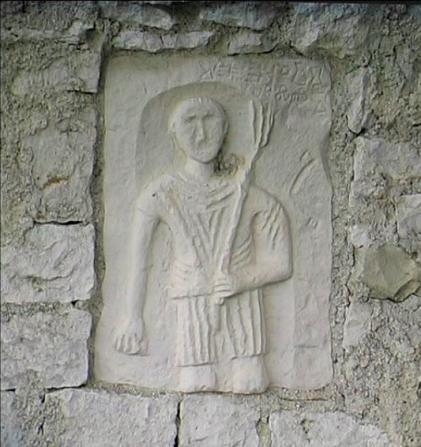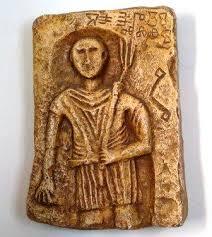Plomin tablet
Plomin tablet


Like this article?
Recommend it to your friends through these services..
The Plomin tablet, the oldest Croatian Glagolitic inscription, from the 11th century, carved on the edge of a late antique slab is dominated by a relief figure that some researchers assume is the Illyrian-Roman god Silvanus, and others deem that it is a more humble person – a farmer, soldier or fisherman. During installation in the outer wall of the church of St. George the Elder in Plomin in the early Middle Ages, a carved figure, based on the typical attribute of having a green branch in his hand (instead of Silvanus' pitchfork or some other tool), was interpreted as the church’s namesake.
On the short inscription, with extremely important palaeographic data documenting the development of round towards angular Glagolitic script (constitutional), there is an unfinished note: se e pisъlъ s(...), that is: “this was written (painted, decorated, carved?) with ...”. In 1850, Mijat Sabljar was the first to redraw the inscription and informed I. Kukuljević Sakcinski about it, and the reading and palaeographic interpretation was compiled by B. Fučić (1952). In his work "Saint George and Green George", Fučić expressed the opinion that the figure on the relief represents Saint George, to whom the church in Plomin is dedicated. Obviously, the old people of Plomin also assumed that the relief represented St. George. As an argument, Fučić used the trefoil branch that the figure on the relief holds in his hand, that is the palm tree, a symbol of martyrs, as it can be interpreted in Christian iconography.
However, later Fučić himself changed his opinion, considering that in the 10th century there was no painting of St. George (at least none have been preserved). If we assume that the relief represents St. George, it is unlikely that the stonemason would forget to carve a halo around his head. Therefore, Fučić still opted for the opinion that the relief depicts Silvanus, the Roman-Illyrian god of flora and fauna, who is seen with a vegetation attribute in his hand using similar iconography as found on an ancient Istrian relief in the museum in Buzet. Such an opinion still prevails today. The Plomin tablet, as the oldest Glagolitic inscription, is evidence of early Croatian literacy in Istria.
